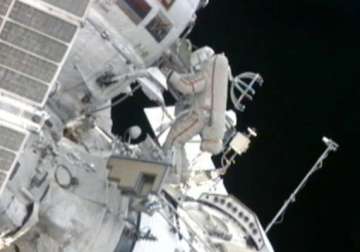Cape Canaveral, Florida, Aug 21 : Spacewalking astronauts improved the safety of their orbiting home Monday by installing shields to protect against zooming pieces of junk.
Gennady Padalka and Yuri Malenchenko hung the panels on the Russian side of the International Space Station, after moving a bulky crane and tossing overboard a small spherical satellite.
The Russian spacewalking powerhouse -- the two have 14 spacewalks between them -- kept going even after Mission Control in Moscow advised them to take a break 3½ hours into their six-hour excursion.
They surged ahead despite a late start to Monday's spacewalk, the first at the space station in six months.
A leaky valve somewhere on the Russian side forced the crew to reopen the air lock and check the seals to ensure a tight fit, before Padalka and Malenchenko could go out.
Padalka assured flight controllers they were in no rush, but admitted it was "kind of boring" to wait an extra hour.
The five 1-inch-thick micrometeorite debris panels were supposed to be installed during a previous spacewalk in February, but got put on hold when other work ran long. The pieces were hauled up by the now-retired space shuttles.
Armor is needed to reinforce the Russian segment, which unlike the U.S. compartments, arrived without the proper protection already in place. Such shielding is crucial given the booming threat of space junk; even a tiny scrap can inflict damage.
A 46-foot crane, meanwhile, needed to be moved from one spot on the Russian portion of the space station to another, in advance of the arrival of a new chamber a year or two from now.
The astronauts used a companion crane for the job.
And the 9-kilogram, 1.7-foot -diameter research satellite hurled by Padalka will orbit for about three months before burning up in the atmosphere, allowing Russian engineers to track its movement as part of a study on space junk.
This was the ninth spacewalk for Padalka and the fifth for Malenchenko. It was overseen from Moscow and went so well that flight controllers added some extra chores for the two.
The only snag was an experiment that wouldn't close properly for retrieval; the spacewalkers were told to leave it outside.
"Five hours did you say?" one of the spacewalkers asked at the five-hour mark. "Oh, we can stay for another hour, what do you think?"
"That's it," Mission Control replied. The two were urged to "marvel at the world around you" before taking some pictures and calling it quits. The spacewalk lasted six hours.
An American and a Japanese astronaut will venture out next week on a NASA-directed spacewalk.
Spacewalks are no longer commonplace, now that the space station is virtually complete and running fairly trouble-free. It is home to six astronauts.
Latest World News
